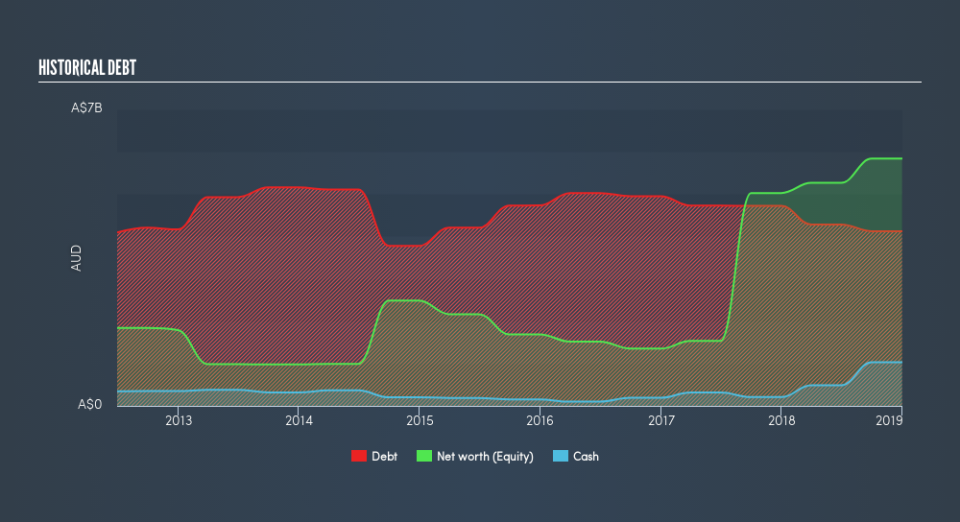What Investors Should Know About Yancoal Australia Ltd's (ASX:YAL) Financial Strength

Want to participate in a short research study? Help shape the future of investing tools and you could win a $250 gift card!
Small and large cap stocks are widely popular for a variety of reasons, however, mid-cap companies such as Yancoal Australia Ltd (ASX:YAL), with a market cap of AU$4.2b, often get neglected by retail investors. However, generally ignored mid-caps have historically delivered better risk-adjusted returns than the two other categories of stocks. Let’s take a look at YAL’s debt concentration and assess their financial liquidity to get an idea of their ability to fund strategic acquisitions and grow through cyclical pressures. Don’t forget that this is a general and concentrated examination of Yancoal Australia’s financial health, so you should conduct further analysis into YAL here.
View our latest analysis for Yancoal Australia
YAL’s Debt (And Cash Flows)
YAL has shrunk its total debt levels in the last twelve months, from AU$4.7b to AU$4.1b – this includes long-term debt. With this debt repayment, the current cash and short-term investment levels stands at AU$1.0b to keep the business going. On top of this, YAL has generated AU$1.7b in operating cash flow over the same time period, leading to an operating cash to total debt ratio of 42%, signalling that YAL’s current level of operating cash is high enough to cover debt.
Can YAL meet its short-term obligations with the cash in hand?
Looking at YAL’s AU$913m in current liabilities, the company has maintained a safe level of current assets to meet its obligations, with the current ratio last standing at 2.11x. The current ratio is the number you get when you divide current assets by current liabilities. Usually, for Oil and Gas companies, this is a suitable ratio since there's a sufficient cash cushion without leaving too much capital idle or in low-earning investments.
Does YAL face the risk of succumbing to its debt-load?
With debt reaching 71% of equity, YAL may be thought of as relatively highly levered. This is not uncommon for a mid-cap company given that debt tends to be lower-cost and at times, more accessible. No matter how high the company’s debt, if it can easily cover the interest payments, it’s considered to be efficient with its use of excess leverage. A company generating earnings after interest and tax at least three times its net interest payments is considered financially sound. In YAL's case, the ratio of 4.72x suggests that interest is appropriately covered, which means that debtors may be willing to loan the company more money, giving YAL ample headroom to grow its debt facilities.
Next Steps:
Although YAL’s debt level is towards the higher end of the spectrum, its cash flow coverage seems adequate to meet obligations which means its debt is being efficiently utilised. Since there is also no concerns around YAL's liquidity needs, this may be its optimal capital structure for the time being. This is only a rough assessment of financial health, and I'm sure YAL has company-specific issues impacting its capital structure decisions. You should continue to research Yancoal Australia to get a better picture of the mid-cap by looking at:
Future Outlook: What are well-informed industry analysts predicting for YAL’s future growth? Take a look at our free research report of analyst consensus for YAL’s outlook.
Valuation: What is YAL worth today? Is the stock undervalued, even when its growth outlook is factored into its intrinsic value? The intrinsic value infographic in our free research report helps visualize whether YAL is currently mispriced by the market.
Other High-Performing Stocks: Are there other stocks that provide better prospects with proven track records? Explore our free list of these great stocks here.
We aim to bring you long-term focused research analysis driven by fundamental data. Note that our analysis may not factor in the latest price-sensitive company announcements or qualitative material.
If you spot an error that warrants correction, please contact the editor at editorial-team@simplywallst.com. This article by Simply Wall St is general in nature. It does not constitute a recommendation to buy or sell any stock, and does not take account of your objectives, or your financial situation. Simply Wall St has no position in the stocks mentioned. Thank you for reading.



